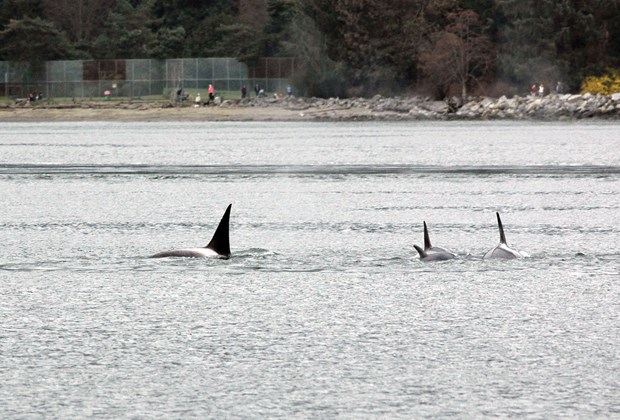Some lucky North Shore residents were treated to a special glimpse of the wild kingdom Thursday morning when a pod of killer whales was spotted in Burrard Inlet and up Indian Arm, most likely in search of some warm-blooded grub.
A group of five or six killer whales were seen swimming in the inlet between 8 a.m.and 11 a.m., according to reports that came in to the B.C. Cetacean Sightings Network — a citizen science project which collects data on sightings.
The whales were initially spotted near Belcarra in Indian Arm at around 8 a.m. An hour later sightings were reported near Deep Cove and by 10 a.m. they were spotted near the Chevron refinery in Burrard Inlet.
An hour later members of the sightings network spotted the whales near the Lions Gate Bridge.
The network first heard about the whales from a member of the public calling the B.C. Cetacean Sightings Network hotline around 10 a.m., said Tessa Danelesko, co-ordinator of the group.
The whales spotted were identified as an older adult male and female, two younger adult whales and a young calf.
According to Danelesko, killer whales travelling up the Indian Arm are “extremely rare,” a trek Carla Crossman, marine mammal research biologist at the Vancouver Aquarium, said the creatures likely made in a hunt for food.
“They were probably coming in to feed. These were transient or Bigg’s killer whales, that feed exclusively on marine mammals. Up near Deep Cove/Indian Arm there’s a lot of harbour seals in the area and so they probably came in to look for some food,” said Crossman.
Crossman said the transient killer whale’s diet differs from the more commonly spotted resident killer whales, which travel in more cohesive groups and dine almost exclusively on fish.
Transients tend to travel in smaller groups and feast on a variety of sea mammals.
“Transient killer whales are marine mammal eaters, so they’re eating the seals, sea lions, porpoises (and) dolphins.”
According to Crossman, transient groups generally enter the inlet about once or twice a year, making sightings in this area somewhat rare.
But she said it’s ultimately hard to know just how often these groups enter the area and how frequently they head up the Indian Arm. “They might be coming in at night and we might not be noticing as much.”



